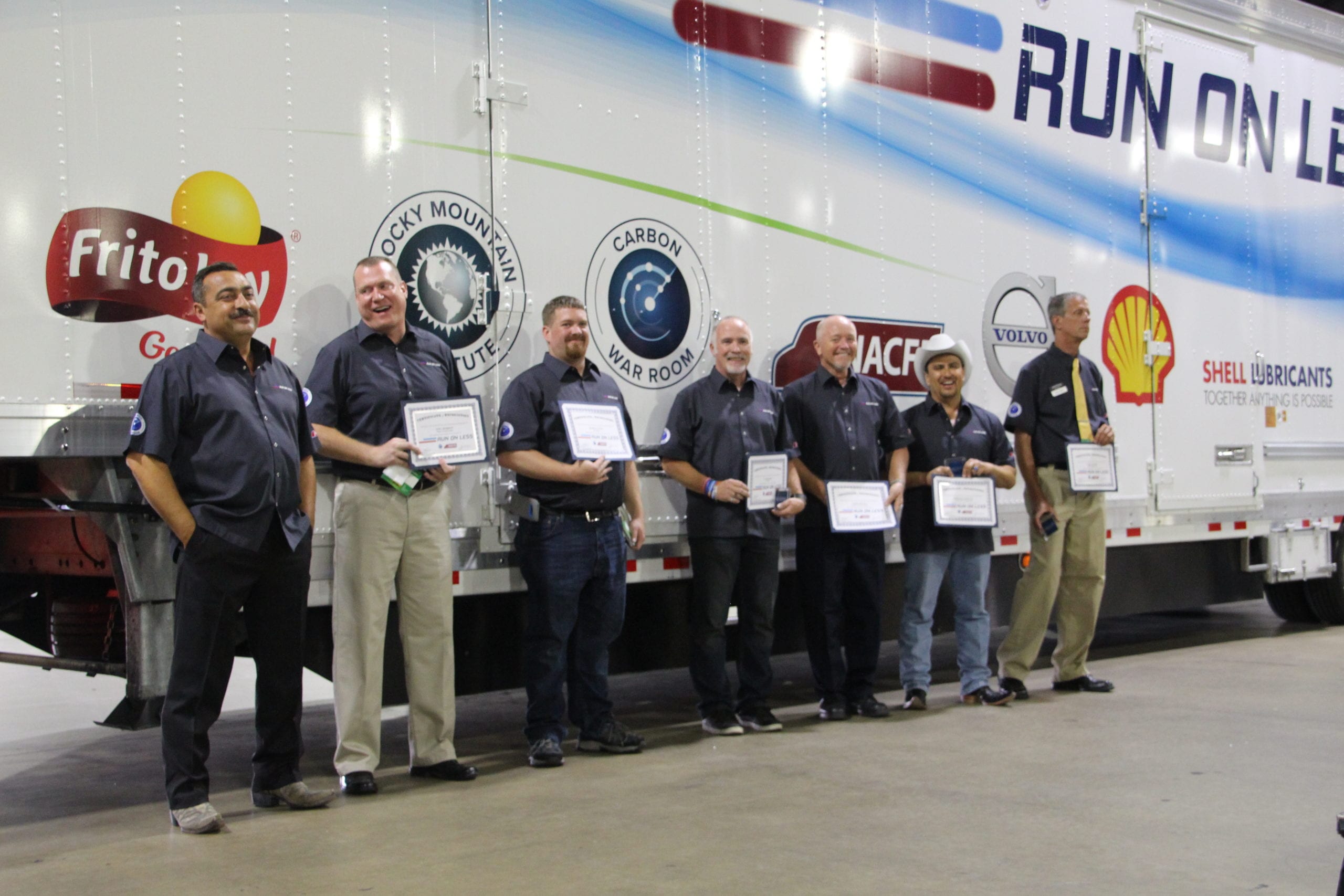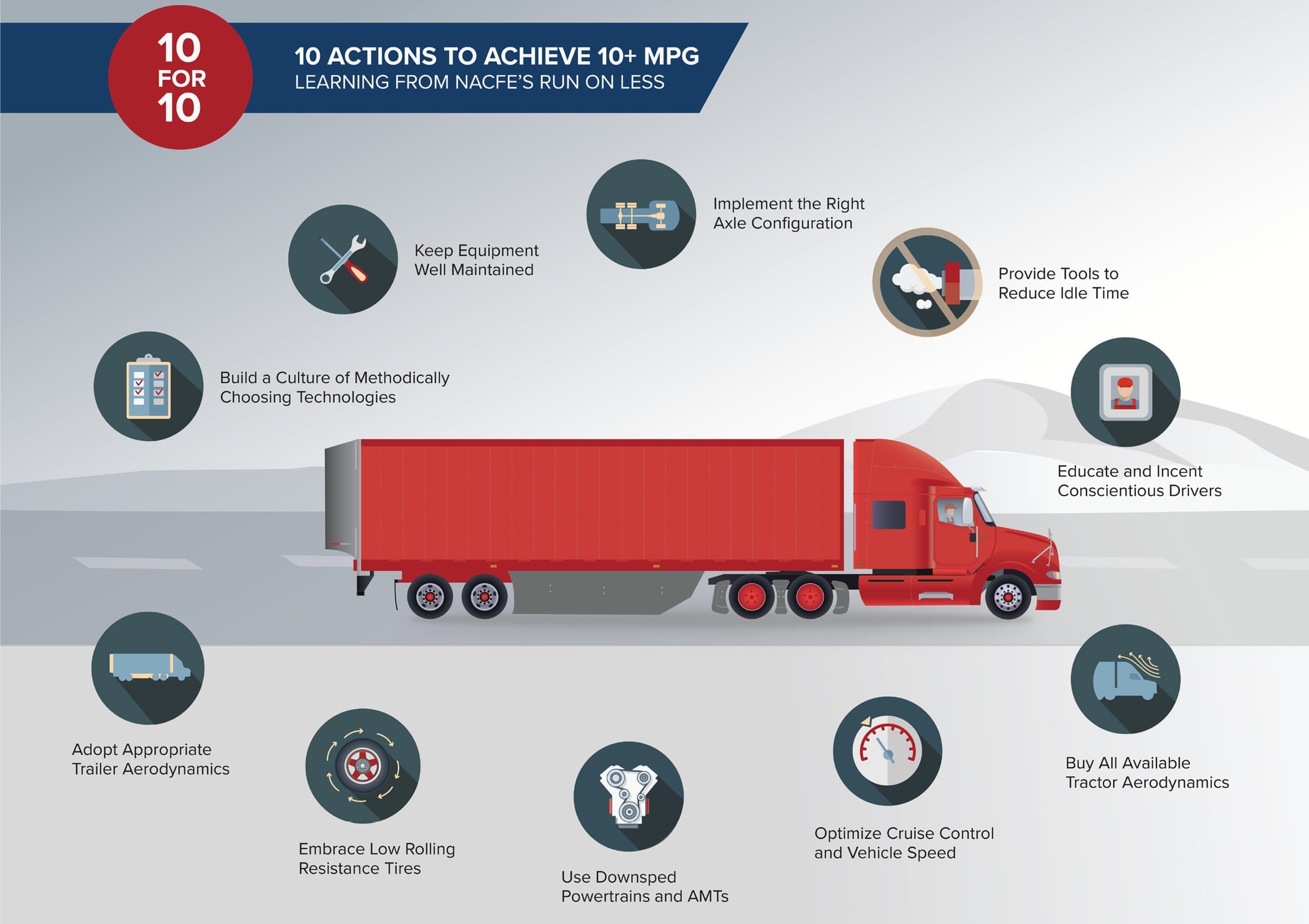When it comes to freight efficiency in Class 8 over-the-road trucks, 10.1 MPG is possible. This was proven last fall when the North American Council for Freight Efficiency held the first of its kind fuel economy road show, Run on Less.
Seven drivers from seven fleets drove trucks loaded with real freight a total of 50,107 miles over the course of 17 days, which equaled 99 truck-driving-days. The seven trucks averaged 10.1 MPG, which bests the national average of 6.4 MPG by a wide margin and surpasses NACFE’s expectation of 9 MPG at the start of the Run. Five truck days were between 7.0 and 8.0 MPG and four truck days were between 12.5 and 13.0 MPG.
The seven trucks averaged 10.1 MPG, which bests the national average of 6.4 MPG by a wide margin and surpasses NACFE’s expectation of 9 MPG at the start of the Run.
The trucks totaled 543,903 feet in elevation gain and encountered various weather conditions including Hurricanes Harvey and Irma. In addition, overall average speed during the Run was 54 mph with all drivers recording some time at 65 mph.
All technologies on the trucks had to be commercially available and while there were some common technologies among the trucks no two trucks were spec’d the same way.
Common technologies included:
- All-inclusive tractor aerodynamics including sloped hoods, bumper dams, aerodynamic mirrors, chassis fairings, full height roof fairings, cab extenders, vented mud flaps and drive wheel fairings with wheel covers
- Low rolling resistance tires on nearly all wheel ends
- Automated manual transmissions
- Downsped powertrains at 2.67 or faster
- Low viscosity engine lubrication
- Engine programing for idle shutdown and diesel-fired heaters for idle reduction during cold weather
- All trailers used automatic tire pressure systems
- Some sort of trailer aerodynamics under and back of the trailer
- Telematics and driver aids of various kinds
Differences in the vehicles included:
- Axle configurations with fleets using 4×2, 6×4, 6×2 tag and 6×2 liftable
- Wide variation on engine size from 11 to 13 and 15L engines
- Battery HVAC was the most common choice on four trucks; one used a diesel APU and two without any idle reduction technology for hot weather
- Tires were diverse with respect to wide-based and duals as well as differing tire choices for 6×2 drive and tag axles
- The trailers used three different tail devices, side skirts predominately with one trailer using an undertray device
- One trailer was a high-cube drop-frame to maximizing loading and incorporated side skirts, a trailer tail and a nose cone
- Most drivers utilized various driver behavior tools in the cab
Following the Run, members of the NACFE team spent time evaluating the data, which tracked not only fuel usage, but also vehicle speed, wind speed, elevations changes and more.
The team reached four main conclusions:
- 10 MPG does happen in the real world
- Conditions matter when it comes to achieving good fuel economy and fleets need to understand that so they can make the right decisions for their specific operation
- High MPG results from efforts applied in a number of areas including initial vehicle specs, added efficiency technologies, and driver behavior
- Telematics reports and data logging are worthwhile investments
By sifting through all the data collected during the Run, the NACFE team was able to come up with recommended actions that fleets should take to improve their fuel efficiency.
- Use downsped powertrains and automated manual transmissions. AMTs enable downspeeding but duty cycle is key when deciding to downspeed. The most aggressive downspeeding is for tractors with high average speed and few stops and starts.
- Educate and incent drivers. Drivers are a key part of the fuel efficiency equation. Hire, educate and incent drivers to achieve the best fuel efficiency.
- Buy all available tractor aerodynamics. When spec’ing, fleets should say yes to all available aerodynamics on their sleeper tractors. They have a high ROI and make sense in line haul applications.
- Adopt appropriate trailer aerodynamics. Trailer aero needs to be looked at in relation to side, rear and front.
- Optimize cruise control and vehicle speed. Maximize engine parameters for cruise control to gain the most fuel savings.
- Keep equipment well maintained. Solid maintenance practices will keep fuel saving technologies operating as they should, so the fleet can get the maximum benefit from their investments. Also use technology that helps equipment run as it is intended. This includes things like automatic tire inflation systems, use of low viscosity lubricants, alignment, etc.
- Implement the right axle configuration. Axle configuration depends on payload, speed and maneuverability.
- Embrace low rolling resistant tires. These tires are a critical factor in achieving high MPG but a tire management process is needed.
- Provide tools to reduce idle time. Encourage drivers to shut the truck off whenever possible. A combination of the proper engine parameters and technology will allow fleets to do that.
- Build a culture of methodically choosing technologies. Fleets need to have a process in place that allows them to constantly monitor, adjust and react to new fuel-saving technologies that become available.
The full report, graphics package and dataset can be downloaded for free given the gracious sponsorship of many companies at https://nacfe.org/run-on-less-report/ NACFE board chairman Rob Reich, senior vice president of equipment, maintenance and driver development at Schneider, said, “I hope all fleets, manufacturers and others will use the data derived from Run on Less as part of their strategies to lower fuel costs and emissions. Thanks to everyone involved with the run, which has helped provide this excellent source of information for all our efforts to make trucking more efficient.”




